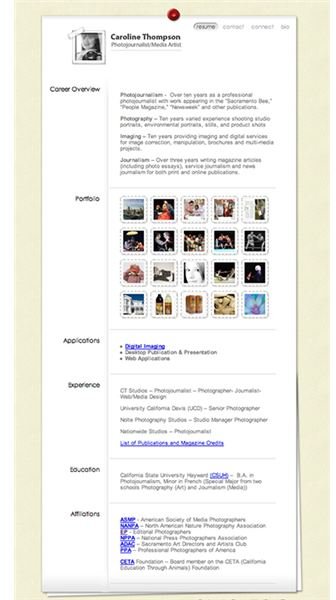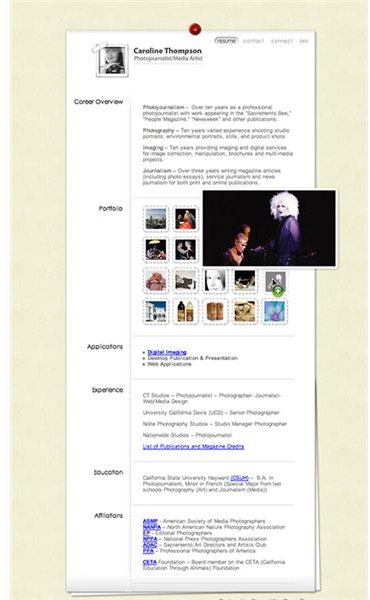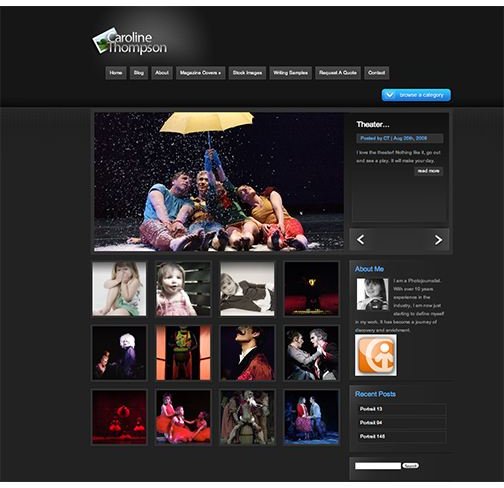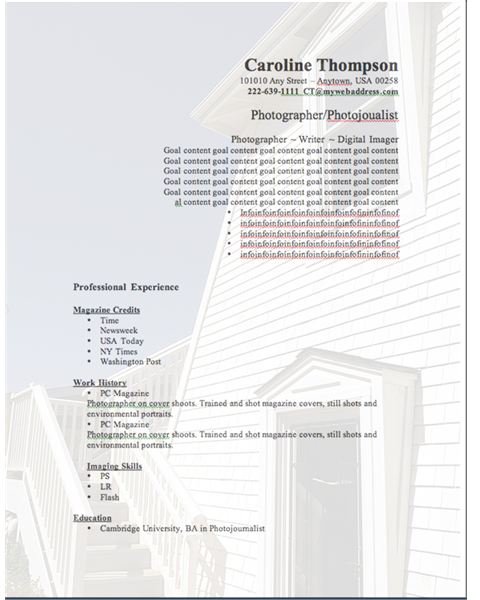What Does a Photographer Resume Look Like? Tips on How to Build a Photographer's Resume
Regular Resume vs. Photographer’s Resume
In a regular resume, the information is broken down into four categories: education, work history, skills and goals. Regular resumes do not show skill level or creativity. A photographer’s resume must have all of the above and a portfolio section that shows their best work. The visual section of the resume is the most important piece of the photographer’s resume because it shows the employer or client the level of skills and creativity of the photographer.
Resume Types
Photography is a visual medium and the best selling points a photographer has is a good visual presentation. Before the digital age, photographers created portfolios that included mounted 8x10 images or 8x10 images in portfolio book. This included a typed page that listed all their credits, work history and education. The typed resume was the same format as any other resume. This was a straight forward presentation of their best work with a bio, which worked well for getting the job or client to use the photographer’s services.
Digital photography changed many ways that a photographer presents himself/herself. Now, there are various means of presenting a resume to a client, such as:
- Photographer website
- Digital resume and portfolio
- Resume website
- Flash presentation
- PDF file
- Standard print resume
The photographer’s resume is a two-part resume. Work history, education, skills and goals are laid out like a standard resume. The portfolio section can be done in a variety of ways. The key is to have a visually engaging portfolio and a creative way of presenting the work. Photography is not only about capturing the image, but also about imaging.
Background History
Work history, education and skills should be written up in clearly defined sections. The general rule of thumb is to put the intro and goals at the top of the page and follow with the other sections.
- Professional experience
- Skills (Any imaging applications or other related skills would go here)
- Education
The resume sample is a general format outline. This can be sent through E-mail, mailed, sent as a PDF or put on separate page in a website resume.
Portfolio Section
The portfolio is the meat of the resume. It can be presented in a variety of ways, such as:
- Website resume
- Photographer’s visual website (using only pictures with limited text)
- Flash presentation
Website Resume
The website resume is very functional. It has all the standard resume information, but with the portfolio presented with the information on a single page. Work history specifics and skills are linked as pop-up menus. This professional look works for photographer’s looking for a job in the magazine or media industry as an employee. The resume can be viewed on the web by sending the client a link.


Photographer’s Website
Photographer’s websites mainly focus on the best images in a portfolio and show some design skills. This type of resume portfolio works well with advertising agencies and photographer’s looking for contract work. The resume can be viewed on the web by sending the client a link.

Flash Presentations
Flash presentations can be visually enticing with special effects and graphics. These work well for photographers that are looking to work with animators and for web-based work. The type of presentations is limitless. Depending on the skill of the photographer, they can build the site or use a site builder.
Summary
The type of work being sought will determine the type of resume a photographer should use. Background information is important and must be included, but the potential employer (client) is more interested in the visual images. Choose a method of presenting the portfolio that closely fits the type of work you will be performing.
